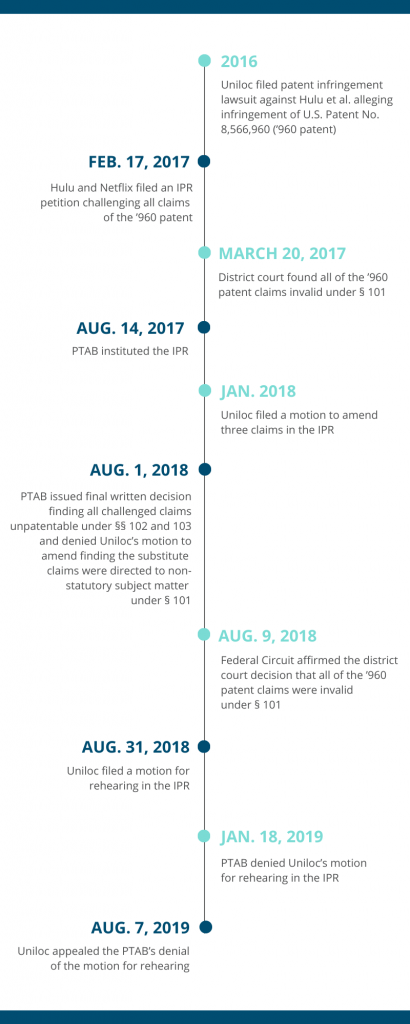By: Katie Becker and Alaina Pak[i]
On July 22, the U.S. Court of Appeals for the Federal Circuit decided 2-1 that the Patent Trial and Appeal Board (PTAB) may consider patentability issues outside of 35 U.S.C. §§ 102 and 103 when evaluating substitute claims in inter partes review (IPR) proceedings.
The numerous and complex disputes underlying the Federal Circuit’s decision are distilled in the timeline to the right, which can also be viewed here.
Affirming the PTAB’s denial of Uniloc’s motion for rehearing, finding that the PTAB may analyze § 101 patent eligibility for proposed substitute claims, the Federal Circuit first analyzed where it lacked jurisdiction. In doing so, the Federal Circuit found that Uniloc’s appeal and the underlying IPR were not moot. Uniloc’s potential relief on appeal was a certificate of issuance for its substitute claims. Also, consistent with the Manual of Patent Examining Procedure and 35 U.S.C. § 316(d), which allows patentees to propose substitute claims by filing a motion to amend, the PTAB may consider substitute claims after original claims are held invalid by a final federal-court judgment.
Next, the Federal Circuit analyzed the text, structure, and history of the IPR statutes and found that, when reviewing substitute claims in an IPR, the PTAB is not limited by § 311(b) and may consider § 101 eligibility. By the text and plain language of the IPR statutes, § 318(a) requires the PTAB to issue a final written decision “with respect to the patentability of . . . any new claim added under 316(d),” and any § 101 analysis is included in patentability determinations. Furthermore, § 311(b) limits IPR analysis to §§ 102 and 103 when petitioners request the “cancellation” of existing “claims of a patent.” Proposed substitute claims are not “claims of a patent,” and unissued claims cannot be cancelled. As such, substitute claims are not limited by § 311(b).
The Court also reasoned that, based on legislative history, reexamination is meant to be limited to “substantial new questions of patentability,” which are questions that have not yet been considered by the U.S. Patent and Trademark Office (USPTO). Moreover, “[p]roposed substitute claims in an IPR proceeding have not undergone a patentability review by the USPTO” like existing claims have, so the substitute claims necessarily raise “substantial new questions of patentability,” including questions of eligibility under § 101. The Court agreed with the USPTO’s warning that patentees could bypass §§ 101 and 112 requirements and obtain new claims fraught with patentability issues if amendments in IPRs were not also subject to these statutes.
In her dissent, Judge Kathleen M. O’Malley described Uniloc’s appeal as “dead on arrival.” She concluded that Uniloc did not have any “original claims to substitute out for the new claims” after the district court invalidated the challenged claims of the ’960 patent – a decision that was affirmed by the Federal Circuit. She also opined that the majority has shifted the “mammoth task of examining claims” from examiners to Administrative Patent Judges, ignoring the “clear framework of the IPR provisions.”
Key Takeaway: In IPR proceedings, the PTAB still cannot evaluate challenged claims under §§ 101 or 112, but it does have statutory authority to consider §§ 101 and 112 when evaluating substitute claims.
For more information about the content in this alert or if you have questions about the business and legal implications of the Court’s decision, please contact a Banner Witcoff attorney
[i] Alaina Pak is a second-year law student at The University of Southern California Gould School of Law and a 2020 summer associate at Banner Witcoff.
Posted: July 27, 2020



